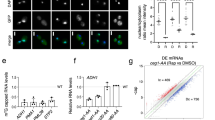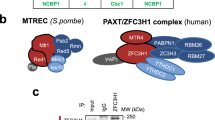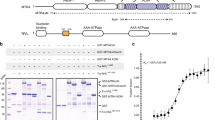Abstract
Nuclear processing and quality control of eukaryotic RNA is mediated by the RNA exosome, which is regulated by accessory factors. However, the mechanism of exosome recruitment to its ribonucleoprotein (RNP) targets remains poorly understood. Here we report a physical link between the human exosome and the cap-binding complex (CBC). The CBC associates with the ARS2 protein to form CBC–ARS2 (CBCA) and then further connects, together with the ZC3H18 protein, to the nuclear exosome targeting (NEXT) complex, thus forming CBC–NEXT (CBCN). RNA immunoprecipitation using CBCN factors as well as the analysis of combinatorial depletion of CBCN and exosome components underscore the functional relevance of CBC-exosome bridging at the level of target RNA. Specifically, CBCA suppresses read-through products of several RNA families by promoting their transcriptional termination. We suggest that the RNP 5′ cap links transcription termination to exosomal RNA degradation through CBCN.
This is a preview of subscription content, access via your institution
Access options
Subscribe to this journal
Receive 12 print issues and online access
$189.00 per year
only $15.75 per issue
Buy this article
- Purchase on Springer Link
- Instant access to full article PDF
Prices may be subject to local taxes which are calculated during checkout







Similar content being viewed by others
References
Chlebowski, A., Lubas, M., Jensen, T.H. & Dziembowski, A. RNA decay machines: the exosome. Biochim. Biophys. Acta 1829, 552–560 (2013).
Houseley, J. & Tollervey, D. The many pathways of RNA degradation. Cell 136, 763–776 (2009).
Staals, R.H. et al. Dis3-like 1: a novel exoribonuclease associated with the human exosome. EMBO J. 29, 2358–2367 (2010).
Tomecki, R. et al. The human core exosome interacts with differentially localized processive RNases: hDIS3 and hDIS3L. EMBO J. 29, 2342–2357 (2010).
Lykke-Andersen, S., Brodersen, D.E. & Jensen, T.H. Origins and activities of the eukaryotic exosome. J. Cell Sci. 122, 1487–1494 (2009).
Lubas, M. et al. Interaction profiling identifies the human nuclear exosome targeting complex. Mol. Cell 43, 624–637 (2011).
LaCava, J. et al. RNA degradation by the exosome is promoted by a nuclear polyadenylation complex. Cell 121, 713–724 (2005).
Wyers, F. et al. Cryptic pol II transcripts are degraded by a nuclear quality control pathway involving a new poly(A) polymerase. Cell 121, 725–737 (2005).
Vanácová, S. et al. A new yeast poly(A) polymerase complex involved in RNA quality control. PLoS Biol. 3, e189 (2005).
Preker, P. et al. RNA exosome depletion reveals transcription upstream of active human promoters. Science 322, 1851–1854 (2008).
Arigo, J.T., Eyler, D.E., Carroll, K.L. & Corden, J.L. Termination of cryptic unstable transcripts is directed by yeast RNA-binding proteins Nrd1 and Nab3. Mol. Cell 23, 841–851 (2006).
Thiebaut, M., Kisseleva-Romanova, E., Rougemaille, M., Boulay, J. & Libri, D. Transcription termination and nuclear degradation of cryptic unstable transcripts: a role for the nrd1-nab3 pathway in genome surveillance. Mol. Cell 23, 853–864 (2006).
Vasiljeva, L. & Buratowski, S. Nrd1 interacts with the nuclear exosome for 3′ processing of RNA polymerase II transcripts. Mol. Cell 21, 239–248 (2006).
Steinmetz, E.J., Conrad, N.K., Brow, D.A. & Corden, J.L. RNA-binding protein Nrd1 directs poly(A)-independent 3′-end formation of RNA polymerase II transcripts. Nature 413, 327–331 (2001).
Gruber, J.J. et al. Ars2 links the nuclear cap-binding complex to RNA interference and cell proliferation. Cell 138, 328–339 (2009).
Izaurralde, E. et al. A nuclear cap binding protein complex involved in pre-mRNA splicing. Cell 78, 657–668 (1994).
Rasmussen, E.B. & Lis, J.T. In vivo transcriptional pausing and cap formation on three Drosophila heat shock genes. Proc. Natl. Acad. Sci. USA 90, 7923–7927 (1993).
Görnemann, J., Kotovic, K.M., Hujer, K. & Neugebauer, K.M. Cotranscriptional spliceosome assembly occurs in a stepwise fashion and requires the cap binding complex. Mol. Cell 19, 53–63 (2005).
Flaherty, S.M., Fortes, P., Izaurralde, E., Mattaj, I.W. & Gilmartin, G.M. Participation of the nuclear cap binding complex in pre-mRNA 3′ processing. Proc. Natl. Acad. Sci. USA 94, 11893–11898 (1997).
Hosoda, N., Kim, Y.K., Lejeune, F. & Maquat, L.E. CBP80 promotes interaction of Upf1 with Upf2 during nonsense-mediated mRNA decay in mammalian cells. Nat. Struct. Mol. Biol. 12, 893–901 (2005).
Izaurralde, E. et al. A cap-binding protein complex mediating U snRNA export. Nature 376, 709–712 (1995).
Cheng, H. et al. Human mRNA export machinery recruited to the 5′ end of mRNA. Cell 127, 1389–1400 (2006).
Ohno, M., Segref, A., Bachi, A., Wilm, M. & Mattaj, I.W. PHAX, a mediator of U snRNA nuclear export whose activity is regulated by phosphorylation. Cell 101, 187–198 (2000).
Kataoka, N., Ohno, M., Moda, I. & Shimura, Y. Identification of the factors that interact with NCBP, an 80 kDa nuclear cap binding protein. Nucleic Acids Res. 23, 3638–3641 (1995).
Boulon, S. et al. PHAX and CRM1 are required sequentially to transport U3 snoRNA to nucleoli. Mol. Cell 16, 777–787 (2004).
Balatsos, N.A., Nilsson, P., Mazza, C., Cusack, S. & Virtanen, A. Inhibition of mRNA deadenylation by the nuclear cap binding complex (CBC). J. Biol. Chem. 281, 4517–4522 (2006).
Domanski, M. et al. Improved methodology for the affinity isolation of human protein complexes expressed at near endogenous levels. Biotechniques 0, 1–6 (2012).
Poser, I. et al. BAC TransgeneOmics: a high-throughput method for exploration of protein function in mammals. Nat. Methods 5, 409–415 (2008).
Hubner, N.C. & Mann, M. Extracting gene function from protein-protein interactions using Quantitative BAC InteraCtomics (QUBIC). Methods 53, 453–459 (2011).
Kiriyama, M., Kobayashi, Y., Saito, M., Ishikawa, F. & Yonehara, S. Interaction of FLASH with arsenite resistance protein 2 is involved in cell cycle progression at S phase. Mol. Cell Biol. 29, 4729–4741 (2009).
Preker, P. et al. PROMoter uPstream Transcripts share characteristics with mRNAs and are produced upstream of all three major types of mammalian promoters. Nucleic Acids Res. 39, 7179–7193 (2011).
Ntini, E. et al. Polyadenylation site-induced decay of upstream transcripts enforces promoter directionality. Nat. Struct. Mol. Biol. 20, 923–928 (2013).
Hallais, M. et al. CBC-ARS2 stimulate 3′-end maturation of multiple RNA families and favor cap-proximal processing. Nat. Struct. Mol. Biol. 10.1038/nsmb.2720 (24 November 2013).
Andrulis, E.D. et al. The RNA processing exosome is linked to elongating RNA polymerase II in Drosophila. Nature 420, 837–841 (2002).
Hessle, V. et al. The exosome associates cotranscriptionally with the nascent pre-mRNP through interactions with heterogeneous nuclear ribonucleoproteins. Mol. Biol. Cell 20, 3459–3470 (2009).
Hieronymus, H., Yu, M.C. & Silver, P.A. Genome-wide mRNA surveillance is coupled to mRNA export. Genes Dev. 18, 2652–2662 (2004).
Das, B., Butler, J.S. & Sherman, F. Degradation of normal mRNA in the nucleus of Saccharomyces cerevisiae. Mol. Cell Biol. 23, 5502–5515 (2003).
Kuai, L., Das, B. & Sherman, F. A nuclear degradation pathway controls the abundance of normal mRNAs in Saccharomyces cerevisiae. Proc. Natl. Acad. Sci. USA 102, 13962–13967 (2005).
Visa, N., Izaurralde, E., Ferreira, J., Daneholt, B. & Mattaj, I.W. A nuclear cap-binding complex binds Balbiani ring pre-mRNA cotranscriptionally and accompanies the ribonucleoprotein particle during nuclear export. J. Cell Biol. 133, 5–14 (1996).
Glover-Cutter, K., Kim, S., Espinosa, J. & Bentley, D.L. RNA polymerase II pauses and associates with pre-mRNA processing factors at both ends of genes. Nat. Struct. Mol. Biol. 15, 71–78 (2008).
Listerman, I., Sapra, A.K. & Neugebauer, K.M. Cotranscriptional coupling of splicing factor recruitment and precursor messenger RNA splicing in mammalian cells. Nat. Struct. Mol. Biol. 13, 815–822 (2006).
Andreu-Agullo, C., Maurin, T., Thompson, C.B. & Lai, E.C. Ars2 maintains neural stem-cell identity through direct transcriptional activation of Sox2. Nature 481, 195–198 (2012).
Shi, Y. et al. Molecular architecture of the human pre-mRNA 3′ processing complex. Mol. Cell 33, 365–376 (2009).
Narita, T. et al. NELF interacts with CBC and participates in 3′ end processing of replication-dependent histone mRNAs. Mol. Cell 26, 349–365 (2007).
Gruber, J.J. et al. Ars2 promotes proper replication-dependent histone mRNA 3′ end formation. Mol. Cell 45, 87–98 (2012).
Yang, X.C., Burch, B.D., Yan, Y., Marzluff, W.F. & Dominski, Z. FLASH, a proapoptotic protein involved in activation of caspase-8, is essential for 3′ end processing of histone pre-mRNAs. Mol. Cell 36, 267–278 (2009).
Lenasi, T., Peterlin, B.M. & Barboric, M. Cap-binding protein complex links pre-mRNA capping to transcription elongation and alternative splicing through positive transcription elongation factor b (P-TEFb). J. Biol. Chem. 286, 22758–22768 (2011).
Das, R. et al. SR proteins function in coupling RNAP II transcription to pre-mRNA splicing. Mol. Cell 26, 867–881 (2007).
Grzechnik, P. & Kufel, J. Polyadenylation linked to transcription termination directs the processing of snoRNA precursors in yeast. Mol. Cell 32, 247–258 (2008).
Rondón, A.G., Mischo, H.E., Kawauchi, J. & Proudfoot, N.J. Fail-safe transcriptional termination for protein-coding genes in S. cerevisiae. Mol. Cell 36, 88–98 (2009).
Almada, A.E., Wu, X., Kriz, A.J., Burge, C.B. & Sharp, P.A. Promoter directionality is controlled by U1 snRNP and polyadenylation signals. Nature 499, 360–363 (2013).
Gudipati, R.K., Villa, T., Boulay, J. & Libri, D. Phosphorylation of the RNA polymerase II C-terminal domain dictates transcription termination choice. Nat. Struct. Mol. Biol. 15, 786–794 (2008).
Vasiljeva, L., Kim, M., Mutschler, H., Buratowski, S. & Meinhart, A. The Nrd1-Nab3-Sen1 termination complex interacts with the Ser5-phosphorylated RNA polymerase II C-terminal domain. Nat. Struct. Mol. Biol. 15, 795–804 (2008).
Wiśniewski, J.R., Zougman, A., Nagaraj, N. & Mann, M. Universal sample preparation method for proteome analysis. Nat. Methods 6, 359–362 (2009).
Dobin, A. et al. STAR: ultrafast universal RNA-seq aligner. Bioinformatics 29, 15–21 (2013).
Acknowledgements
We thank M. Schmid, S. Lykke-Andersen, M. Lubas, A. Dziembowski and D. Libri for critical comments to the manuscript. Special thanks go to E. Marchal for excellent technical assistance. E. Izaurralde (Max Planck Institute for Developmental Biology) and J. Lykke-Andersen (Division of Biological Sciences at University of California, San Diego) are acknowledged for sharing reagents. This work was supported by the Danish National Research Foundation (grant DNRF58), the Danish Cancer Society and the Lundbeck and Novo Nordisk Foundations (T.H.J.); the US National Institutes of Health (grant U54 GM103511, to M.P.R.), the l'ARC and La Ligue Contre Le Cancer (E.B.), the Foundation for Strategic Research (grant FFL09-0130, to R.S.) and the European Community's Seventh Framework Programme (FP7/2007-2013) under grant no. 241548 (MitoSys, to A.H.).
Author information
Authors and Affiliations
Contributions
M.D. and J.B. performed ACMS experiments and analyzed the data together with J.S.A., J.L. and M.P.R.; I.P. and A.H. contributed tagged cell lines. C.V., M.H. and E.B. performed and analyzed RIP experiments. P.R.A., M.S.K. and A.S. performed experimental RNA analyses. P.R.A. and E.N. performed and analyzed ChIP experiments. P.R.A., H.S. and R.S. analyzed RNA-seq data. P.R.A., M.D., M.S.K. and T.H.J. wrote the manuscript.
Corresponding author
Ethics declarations
Competing interests
The authors declare no competing financial interests.
Integrated supplementary information
Supplementary Figure 1 Validation of near-endogenous expression levels of tagged proteins.
Western blotting analyses of tagged proteins used for AC/MS analyses as well as their endogenous counterparts. Membranes were probed with antibodies targeting the indicated factors. Tagged versions of CBP20, CBP80 and ZC3H18 were expressed at endogenous levels, while tagged versions of ARS2 and hMTR4 were expressed at lower levels than their endogenous versions. RBM7-LAP was ~2-fold overexpressed, which is unlikely to have caused any artificial interactions due to the high level of congruency between AC/MS analyses of RBM7-LAP, hMTR4-LAP and ZCCHC8-FLAG6
Supplementary Figure 2 Co-depletion of major 5'-3' exonucleolytic enzymes does not affect PROMPT levels.
(a) Western blotting analysis of whole cell extracts showing protein depletion upon the indicated siRNA administrations. Membranes were probed with the indicated antibodies. Anti-actin antibody was used as a loading control. (b) XRN1 + XRN2-depletion does not increase PROMPT levels of exosome-depleted cells. Levels of the indicated PROMPTs were measured and displayed as in Fig. 5b.
Supplementary Figure 3 Effect of depletion of CBCA components on transcription termination of the U1- and U8-encoding genes.
(a) Transcriptional read-through analysis of the U1 gene upon the indicated factor depletions and displayed as in Fig. 6b. (b) Northern blotting analysis of total RNA purified from HeLa cells subjected to the indicated siRNA transfections (depletion levels shown in Fig. 5a). Position of the utilized 5'end radiolabeled probe to primarily detect 3'extended U8 RNA species is shown at the top. Factor depletions (Fig. 5a), data display and control were done as in Fig. 5c. (c) Transcriptional read-through analysis of the U8 gene upon the indicated factor depletions and displayed as in Fig. 6b.
Supplementary Figure 4 Mean coverage ratios around TSSs upon CBCN factor depletion.
Plots are displayed similarly to those in Figure 7. (a) PROMPT accumulation upon combinatorial depletion of hRRP40 and CBCN relative to control siRNA. (b) PROMPT accumulation upon combinatorial depletion of ZCCHC8 and CBCN relative to control siRNA. (c) PROMPT accumulation upon combinatorial depletion of ZCCHC8 and CBCN relative to ZCCHC8 depletion. Faded areas represent 95% confidence intervals for each curve.
Supplementary Figure 5 Mean coverage ratios around histone mRNA TSSs upon CBCN factor depletion.
Plots are displayed similarly to those in Fig. 7. For a-d upper panels display the region around annotated 3'ends of mature replication-dependent histone (RDH) genes, while lower panels display that of replication-independent histone (RIH) genes. (a) Mean coverage as tags per event (TPE) at histone gene TTSs. (b) Histone RNA accumulation upon single factor depletion relative to control siRNA. (c) Histone RNA accumulation upon combinatorial depletion of hRRP40 and CBCN relative to control siRNA. (d) Histone RNA accumulation upon combinatorial depletion of hRRP40 and CBCN relative to hRRP40 depletion.
Supplementary Figure 6 Uncropped gel images of northern blots in Figure 5 and Supplementary Figure 3.
(a) Uncropped image of the northern blot shown in Fig. 5c. (b) Uncropped image of the northern blot shown in Supplementary Fig. 3b.
Supplementary information
Supplementary Text and Figures
Supplementary Figures 1–6, Supplementary Tables 1 and 8–13 and Supplementary Note (PDF 1893 kb)
Supplementary Table 2
hMTR4-LAP ACMS (XLSX 36 kb)
Supplementary Table 3
RBM7-LAP ACMS (XLSX 17 kb)
Supplementary Table 4
CBP80–3× FLAG ACMS (XLSX 23 kb)
Supplementary Table 5
CBP20–3× FLAG ACMS (XLSX 17 kb)
Supplementary Table 6
LAP-ARS2 ACMS (XLSX 16 kb)
Supplementary Table 7
ZC3H18–3× FLAG ACMS (XLSX 22 kb)
Rights and permissions
About this article
Cite this article
Andersen, P., Domanski, M., Kristiansen, M. et al. The human cap-binding complex is functionally connected to the nuclear RNA exosome. Nat Struct Mol Biol 20, 1367–1376 (2013). https://doi.org/10.1038/nsmb.2703
Received:
Accepted:
Published:
Issue Date:
DOI: https://doi.org/10.1038/nsmb.2703
This article is cited by
-
Temporal-iCLIP captures co-transcriptional RNA-protein interactions
Nature Communications (2023)
-
The PNUTS-PP1 complex acts as an intrinsic barrier to herpesvirus KSHV gene expression and replication
Nature Communications (2022)
-
The zinc-finger protein Red1 orchestrates MTREC submodules and binds the Mtl1 helicase arch domain
Nature Communications (2021)
-
A first exon termination checkpoint preferentially suppresses extragenic transcription
Nature Structural & Molecular Biology (2021)
-
A transcriptome-wide antitermination mechanism sustaining identity of embryonic stem cells
Nature Communications (2020)



